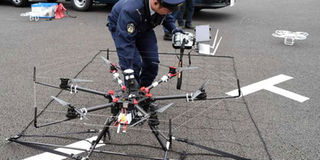UK Police to use Eagles versus drones in the fight against crime

A police officer prepares to fly a drone interceptor during an anti-terrorism drill for the upcoming Tokyo marathon at the planned finish area for the event in Tokyo on January 17, 2016. PHOTO | AFP
What you need to know:
- A clip on social media shows a handler release his eagle in a training area; immediately, it dives onto a small, green-coloured drone in mid-air and carries it away in its talons.
- Drones, which are remotely controlled, are already being used by police to photograph crime scenes or rescue operations in difficult terrain such as cliffs; those fitted with thermal imaging cameras search for missing people and fugitives.
- Ambulance drones have been used to deliver defibrillators to medics tending heart attack victims in the crucial moments after the collapse.
The Metropolitan Police in London are considering using eagles to intercept unmanned aircraft, known as drones, amid concerns that the mini-planes are increasingly used to commit crimes.
A BBC report said trials in Holland demonstrated that eagles can be trained to perceive flying drones as prey, whereupon they swoop on the aircraft and “kill” them.
A clip on social media shows a handler release his eagle in a training area; immediately, it dives onto a small, green-coloured drone in mid-air and carries it away in its talons.
A clip from Australia consists of film taken by a drone itself as it cruises over a forested area; there is a loud thump and the film spins crazily – the drone has been taken by a two-metre-tall wedge-tailed eagle.
Drones, which are remotely controlled, are already being used by police to photograph crime scenes or rescue operations in difficult terrain such as cliffs; those fitted with thermal imaging cameras search for missing people and fugitives.
Ambulance drones have been used to deliver defibrillators to medics tending heart attack victims in the crucial moments after the collapse.
But criminals, too, have figured out how useful drones can be. In November, the Ministry of Justice said a drone was used to smuggle mobile phones, SIM cards and drugs into the grounds of Manchester Prison. The ministry said at least nine attempts to use drones to infiltrate prisons had been discovered in the first five months of 2015.
Airline pilots complain that drones can be a hazard when they are landing or taking off and officials said they had been involved in four serious near misses recently.
USED BY TERRORISTS
A think tank has warned that drones could also be used by terrorists.
Drones range from a foot or so in size to missile-carrying aircraft known as UAVs — Unmanned Aerial Vehicles — which the United States has used against terrorists in hilly countries, travelling in cars or inside a building. Those used by the military have a wing span of 40 metres and can stay aloft for 17 hours.
Some drones can reach an altitude of 30,000 feet and have a range of 200 kilometres. Toy drones have a ceiling of 2,000 feet and a range of two kilometres.
***
There has been a dramatic increase in British people having plastic surgery – 50,000 operations last year, an increase of 10 per cent on 2014.
Women lead the way with breast enlargement, but there has been a noticeable rise among men, who go for tattoo removal, nose reductions, fat removal and eyelid surgery.
***
In an unprecedented move, a judge has ordered a firm of solicitors to pay all of its opponent’s costs in a claim for compensation that proved fraudulent.
The court heard that a bus owned by transport company Go North East scraped the side of a car while driving at five miles per hour. The car driver and the passenger, a child, did not complain of injuries and the damage to the car was paid for by the bus company.
But 18 months later, a claim was made against Go North East after a firm of personal injury lawyers in Macclesfield urged the car driver to do so, suggesting there would be a financial reward. A medical claim was then made that the driver and child had been injured, despite their denial at the time of the accident.
BRING FALSE CLAIMS
The court, however, ruled that the driver, who was the child’s mother, had misled the medical expert.
The judge said there was misconduct by the mother and the solicitors, whose failings he described as “serious and persistent.” The court ruled that the solicitors should pay the bus firm’s costs.
Go North East spokesman Kevin Carr welcomed the decision and said: “At the root of the so-called claims culture in this country appear to be unscrupulous law firms that encourage members of the public to bring false claims in the pursuit of financial gain.”
***
As promised last week, herewith the fictitious tale of a tight-fisted Yorkshireman: The couple had been happily married and living on their farm for more than 50 years when Gladys Braithwaite passed away. Her grieving husband decided to insert the usual death notice in the local paper. But first, how much?
The cost would depend on the space occupied, the salesgirl said. You could publish her photo. Nay, nay, said the farmer, Gladys would not want to show off. Then maybe a small poem? Absolutely not, nothing fancy for Gladys. Just put, “Gladys Braithwaite died November 17, 2015.”
The salesgirl did the necessary calculation. “You can have another four words for the same price,” she said.
Oh good, said the farmer, happily.
The death notice was duly published: “Gladys Braithwaite died November 17, 2015. Also tractor for sale.”





